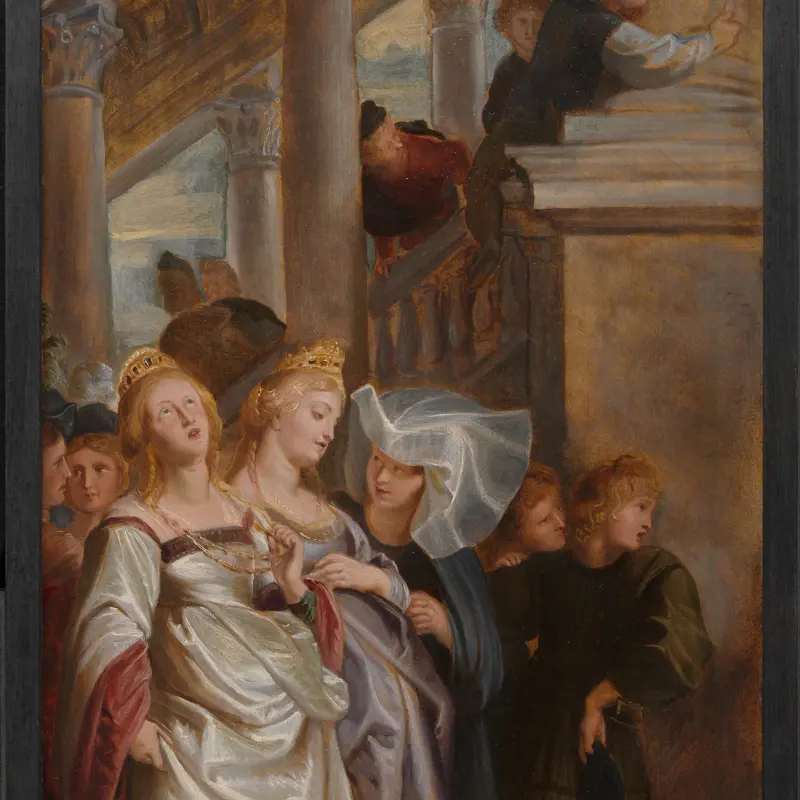Peter Paul Rubens, 'Three Female Witnesses', 1611-12
About the work
Overview
This is an oil sketch Rubens made in preparation for an altarpiece for St Bavo’s Cathedral, Ghent; it shows the scene that appeared on the left panel. The two women wearing gold crowns are Saints Gertrude and Begga, the sisters of Saint Bavo (who appears in the central panel). Saint Bavo was a Roman solider, but he left the military to become a monk; his sisters followed his example by becoming nuns. Judging by her closeness and familiarity, the woman in the white headdress is probably a companion of the sisters, possibly Saint Bavo’s daughter.
Saint Gertrude clutches her necklace as she goes to discard it, just as her brother in the central panel gives away his wealth before entering the monastery. Her head is tipped back and her eyes are raised as if towards heaven. Her gown, its gold embroidery visible on the hem, shimmers in the light, emphasising the wealth that the family are about to give up.
Key facts
Details
- Full title
- Three Female Witnesses
- Artist
- Peter Paul Rubens
- Artist dates
- 1577 - 1640
- Part of the group
- Oil Sketch for High Altarpiece, St Bavo, Ghent
- Date made
- 1611-12
- Medium and support
- oil on wood
- Dimensions
- 107.6 × 41.1 cm
- Acquisition credit
- Holwell Carr Bequest, 1831
- Inventory number
- NG57.2
- Location
- Room 18
- Collection
- Main Collection
- Previous owners
- Frame
- 21st-century Replica Frame
Provenance
Additional information
Text extracted from the ‘Provenance’ section of the catalogue entry in Gregory Martin, ‘National Gallery Catalogues: The Flemish School: circa 1600–circa 1900’, London 1986; for further information, see the full catalogue entry.
Bibliography
-
1986Martin, Gregory, National Gallery Catalogues: The Flemish School, circa 1600 - circa 1900, London 1986
-
2001
C. Baker and T. Henry, The National Gallery: Complete Illustrated Catalogue, London 2001
About this record
If you know more about this work or have spotted an error, please contact us. Please note that exhibition histories are listed from 2009 onwards. Bibliographies may not be complete; more comprehensive information is available in the National Gallery Library.
Images
About the group: Oil Sketch for High Altarpiece, St Bavo, Ghent
Overview
These three oil sketches, or modelli, were made by Rubens in preparation for an altarpiece for St Bavo’s Cathedral, Ghent, which was commissioned by Bishop Maes around 1611. The central panel shows Saint Bavo, a Roman solider who left the military to join the Christian Church, standing on the steps of St Peter’s Church, Ghent. Having given away all his money, he is being received by Saints Amand and Floribert as a monk. The left panel shows Saint Bavo’s sisters, Gertrude and Begga, who followed their brother’s example by becoming nuns. On the right panel, King Clothar and his son King Dagobert argue with a herald of the Roman Emperor Mauritius about a rule that forbade soldiers from becoming monks.





























